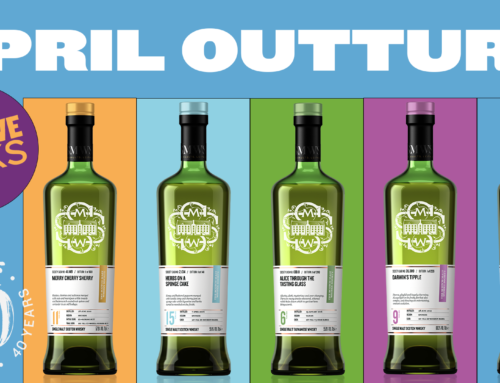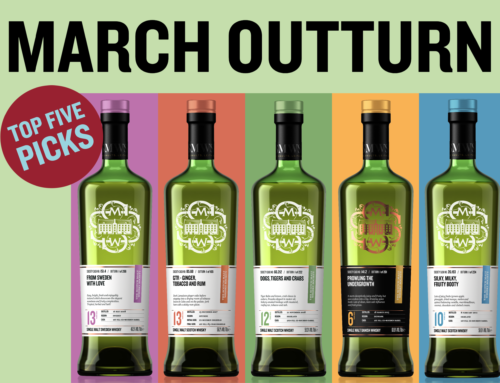Welcome single cask gin to the Society!
Gin?! You might be in a bit of confusion reading that. Yes, a whisky society bottling a cask strength, single cask, gin.
We also bottle single cask rums, Armagnacs, Cognacs, ryes, bourbons, and now a gin. Always in the pursuit of unique and incredible flavours, the Society continues to innovate around this remarkable spirit. When we first bottled Japanese whisky, members tore up their cards, chat rooms were filled with disbelief, and people were gobsmacked. Then they opened the bottle. We continue to innovate and we hope you enjoy this single cask, cask strength, barrel-aged, London Dry style Glaswegian gin! Welcome Cask GN1.3 ‘Coriander meander’, 1 of 256 bottles worldwide, bottled at natural cask strength of 57.8% ABV.
What is gin?
Gin started life as genever, a grain spirit flavoured with juniper and other herbs and spices, made in Holland and Belgium from the 15th century onwards. A grain neutral spirit is redistilled together with the natural flavourings known as botanicals to make up a gin’s unique recipe.
A distillation takes around seven to eight hours to complete, with the first and last parts of the run (the foreshots and feints) discarded as they contain unwanted flavours. The decision to divert the liquid into the spirit receiver is called “making the middle cut” and is a crucial part of the recipe.
What do some of our members think of our recent single cask gin?
“The floral aroma came through pleasantly on the nose from the moment the lid was removed. Tasted neat, this was smooth and light with a strong presence of coastal botanicals. Mixed with Fever Tree Mediterranean tonic water to tease out more surprises, this amazing gin turned smooth and silky to the tongue. One of the most amazing gins I’ve tasted.”
– Andrew Gordon
“The nose sent me to a garden with a huge juniper right in the middle and some lemons lying among rosemary growths. A breeze brought the scent of roses and orange blossoms from the neighbours’ garden. After a while I remembered that I brought a cucumber sandwich with some sage. Adding a little bit of ice revealed cold tea (maybe Earl Grey) and some liquorice. The palate started sweet and sour with a little pepper. Apart from juniper, there was cucumber and lemon peel. Ice revealed Earl Grey and turned the pepper into ginger.”
– Michael Schlueter
“The nose has a scent of violets, aniseed at first, then mellowing to roses and eventually a very sweet smell, like orange candy floss. Neat, there are hints of rosewater. With tonic water there is more juniper, it’s smooth and very drinkable, with an aftertaste of pear drops.”
– Mike Liddle
“This is the kind of gin where you’re not sure if you’re supposed to drink it or use it as a perfume. The nose is extremely expressive with a strong scent of lavender, mixed with essential oils (pine tree, thyme, rose). It feels like you are standing in the middle of a Mediterranean garden in the spring. When drinking the gin, it’s very smooth with very limited bitterness. You find everything you felt in the nose, plus maybe some citrus fruits as well as other aromas: basil, rosemary. The bitterness expresses itself a bit more in the finale. A very floral and expressive spirit, which could provide a lot of options in cocktails.”
– Quentin Leloir
Where can I purchase this gin?
Stocks are extremely limited being single cask, and are served on a first-come first-serve basis, and only to members of the Scotch Malt Whisky Society. Cask GN1.3 Coriander meander is on sale as of Friday 22nd March 2019.
Some interesting gin factoids!
1. The expression ‘Dutch Courage’ comes from the name British soldiers fighting in the Netherlands gave to the tots of genever they were given before they went into battle.
2. London Dry Gin does not have to be made in London. It’s the description of the production process related to this style approved under EU regulations.
3. In gin, the most commonly used botanicals are juniper berries, coriander seeds, orris root, angelica and some form of citrus.
4. The signature serve for gin is the Gin and Tonic. Originally tonic water contained quinine, which was prescribed throughout the British Empire to both prevent and cure malaria. Nowadays quinine is a controlled substance and it’s best to leave the tonic water up to professionals.
5. James Bond liked his Martini “shaken, not stirred” but most bartenders prefer a stirred Martini, as shaking breaks up the ice and causes too much dilution.








